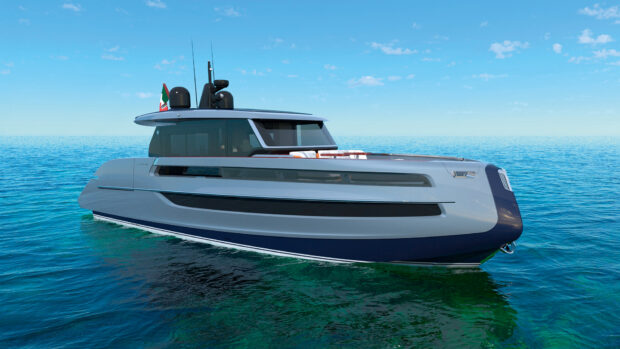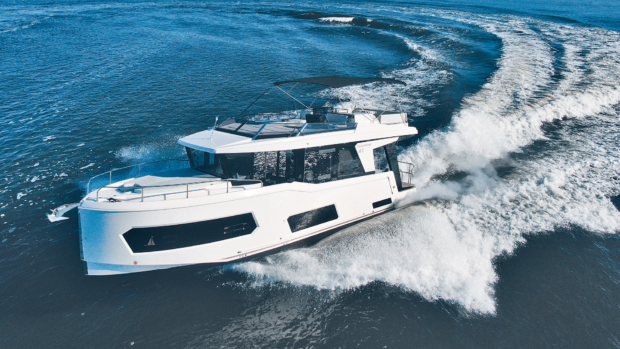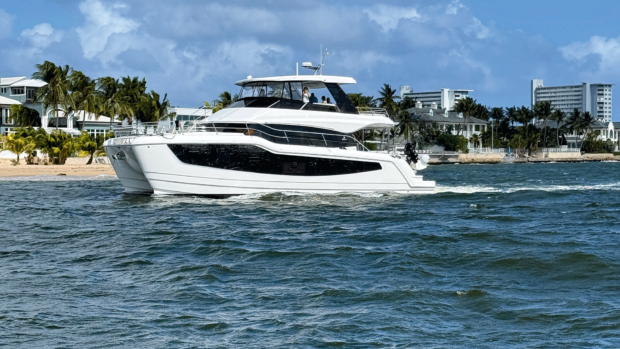A total of 22 motor cruisers taking part in the last Motor Boats Monthly cruise in company of the season have all reached UK ports in good weather.
A total of 22 motor cruisers taking part in the last Motor Boats Monthly cruise in company of the season have all reached UK ports in good weather.
Following a very eventful first week in the North Sea and Belgian canals ( see report here ) life settled down for the mixed fleet spanning a size range of 28ft-51ft and speed range of 6kt-25kt. The exit from Antwerp’s Willemdok was through the giant complex of docks to the Schelde-Rijnverbinding canal. Usually individual boats have to report their ‘FD’ numbers (a pre-registration process that helps to identify craft) on passage through the docks but the harbourmaster at Willemdok, Tony, had been making calls and sending faxes and we had arranged to treat all 22 craft as one long group, with MBM’s Broom 39KLCalm Voyagerin the lead, handling radio traffic and the magazine’s RIB for the season, the 225hp four-stroke Yamaha outboard-powered RibEyeTime Fliesproviding the guard at the rear.
The conga took over two hours to weave its way though the giant complex. There were plenty of barges, tugs and ships to avoid but a lot of water in which to find space out of the way and helpful assistance on the radio from the Antwerp dock authorities.
Once on the Schelde-Rijnverbinding it was soon time to swap the Belgium courtesy flag for the red, white and blue of the Netherlands. Once through the Kreekraksluizen lock two boats took the small lock at Tholen onto the Oosterschelde in order to make for the excellent repair facilities of Delta Marina on the Veersemeer while the rest carried onward to Willemstad. For the MBM control boat crews this was suddenly very familiar territory with no surprises, or so we thought.
Approaching the yacht lock at the Volkeraksluizen we were pleasantly surprised to see the chamber just emptying its westbound incumbents and unpleasantly surprised to see the lights continue to show red and the gates closing. It turned out that dredging operations on the approaches would lead to a long delay. The end of August is still considered to be high summer in the UK, but school was already back in the southern part of the Netherlands and this also apparently signals the re-commencement of maintenance works although this is the first time that we have experienced a delay of this nature in over 15 years of visits.
Fortunately the fortified town of Willemstad, its windmill working in the afternoon breeze, proved to be a suitable prize for all and the local supermarket needed to order a an early morning restock to cope with the sudden influx of boats that were running short of supplies.
After that, the fleet adopted a familiar itinerary of favourites with a run across the Oosterschelde to visit the cosy inner harbour in the town of Goes and then Delta Marina on the Veersemeer where a thunder cell dumped more than an inch of hailstones into cockpits.
The weather had been giving cause for concern all week, thanks to the presence of an ageing hurricane across Scotland and other low-pressure systems. If the respective lows and highs moved by as much as 50nm the wrong way we might have been left with a problem getting out of the Westerschelde and past the often lively waters off Zeebrugge, so careful monitoring all the way down our exit route along the Kanaal door Walcheren past Middleburg to Vlissingen was the order of the day on Saturday (27 August). Fortunately, although there was some residual swell from the previous day’s high winds, the Westerschelde was in spirits that matched the day’s blue skies and the fleet made an easy passage to Nieuwpoort.
The KYCN facilities at Nieuwpoort are currently undergoing refurbishment and an unserviced but modern long pontoon is currently on piles in the approach channel, replacing the old alongside pontoon on the western side of the basin while works are undertaken in that area. The new pontoon will eventually move into the basin on the west side in the next part of several phases of redevelopment to provide more berthing. In keeping with our experiences throughout the trip, the harbourmaster and his team were as helpful and friendly as we have come to expect here and the majority of the fleet took advantage of the onsite bar and restaurant to say their goodbyes.
While we still had to maintain a careful eye on low pressure to the north, it looked like the high had established itself over our area and so an early move was made on the Sunday (28 August) to cross to home ports before afternoon breezes and a slight lift in gradient wind had a chance to bite. The slowest boats in the fleet enjoyed a pre-dawn departure in mirror calm waters, the sun rising into full brilliance when approaching the French border. Thanks to an east-going tide boats heading for south coast ports took a route across the Dover Strait to the west of Cap Gris Nez while the Ramsgate and Thames bound boats turned to starboard earlier for a run across to the East Goodwin. The mixed agenda kept both MBM control boats busy, with the RIBTime Flieslogging two partial Channel crossings near the Varne before going all the way over in earnest and then popping across on a Goodwin lightships tour to meet up with the slowest boats and following them through to Ramsgate.
A sunny afternoon in the Kent port provided a chance to reflect on the previous two weeks. The launch of a new Belgian inland waterways itinerary provided a fascinating contrast to more familiar Dutch waters. There was almost universal recognition among the fleet of the easier boating conditions and family-friendly waters to be found in the Netherlands but in Brugge, Gent and Antwerp we had enjoyed city destinations of great appeal and all were destinations that deserved a greater amount of time to be spent in them. The north of Belgium and Zeeland region of the Netherlands share a lot in common including local language, generally excellent command of English and hospitality. No doubt most of the participant boats will be back for more of the same.










